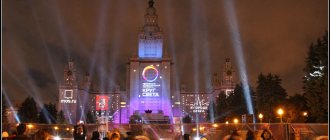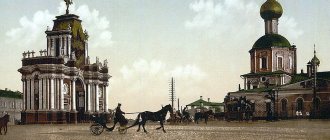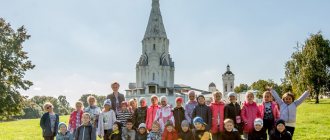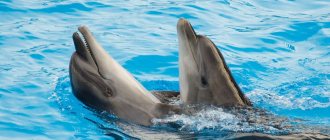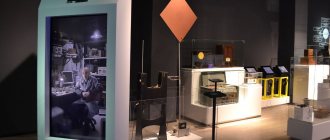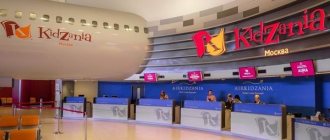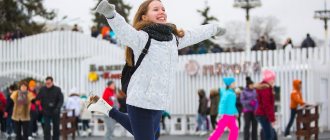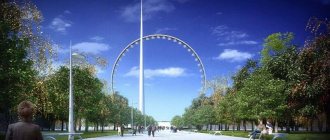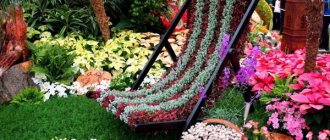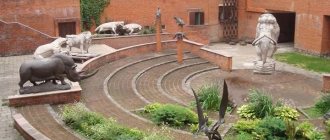How to get to VDNH
There are two ways to get to VDNKh:
Arrival at the metro station of the same name (VDNKh) , just a 15-minute drive from the center of Moscow. Coming out of this station, you can admire the size of the Cosmos Hotel. You can also get there by trolleybus.
- If you are going to visit the Museum of Cosmonautics and the monument to the Conquerors of Space, then after your visit you can go to VDNKh, the main entrance of which is located right next to this museum.
It is also important to know that there is a monorail that crosses part of the Ostankino district and crosses VDNKh. Its length is 4.7 km. It runs from the Ulitsa Sergei Eisenshteina station to the Timiryazevskaya station.
From one of the stops (Telecenter) you will immediately get to the Ostankino TV tower, which I will talk about later. This line is part of the Moscow Metro.
Find excursions around VDNH >>
Contact Information
Information and reference service of VDNKh
| Telephone | +7(495)544-34-00 |
| Fax | +7(495)748-34-80 |
| Email mail | [email protected] |
Press service of JSC "VDNKh"
| Telephone | +7(495)748-34-20 |
| Fax | +7(495)748-34-20 |
| Email mail | [email protected] |
| Accreditation form | download here |
| Internal regulations on the territory of VDNKh | download here |
Feedback
Official name and postal address
Joint Stock Company "Exhibition of National Economic Achievements" (JSC "VDNKh")
129223, Moscow, Mira Avenue, building 119, VDNH
How to get to VDNH
| Metro: | stop “VDNKh metro station” (first car from the center, exit towards VDNH) |
| Buses: | M9, T13, 15, 33, 56, 76, 85, 93, 136, 154, 172, 195, 244, 266, 311, 378, 379, 496, 533, 544, 834, 803, 903, H6 |
| Trolleybuses: | 14, 36, 73, 76 |
| Trams: | 11, 17, 25 |
| Monorail: | stop "Vystavochny" |
Tour agency
The tour desk of the Main Exhibition is located to the left of the Main Arch of VDNKh. More information about excursion programs at VDNKh can be found on the website of the excursion bureau.
Excursion department
| Order excursions by phone: | +7(495) 966-19-29 |
| Email: | [email protected] |
More information about excursion programs can be found in the “Excursions” section on the website cosmos.vdnh.ru
Department of Human Resources and Social Policy
| Email mail | [email protected] |
CURRENT VACANCIES
PROCEDURE FOR VEHICLE ACCESS TO THE TERRITORY OF VDNH
Entry and exit of vehicles into the territory of VDNKh is carried out through specially equipped checkpoints (checkpoints) on the basis of payment in accordance with established tariffs.
In order to ensure security upon entry and exit, employees of authorized security structures conduct a mandatory inspection of vehicles. Refusal to undergo an inspection is grounds for prohibiting the passage of vehicles into the territory of VDNKh.
Entry into the territory of freight vehicles, vehicles belonging to the type of special construction, road repair, loading and unloading, municipal equipment, etc., as well as all other vehicles importing building materials and structures into the territory of VDNKh, is carried out on the basis prior agreement with the authorized structural divisions of JSC VDNKh.
Entry into the territory of VDNH of vehicles transporting fuels and lubricants, flammable substances, etc. is prohibited.
In case of refusal to enter the territory (exit from the territory) of VDNKh, the driver of the vehicle is obliged to vacate the 50-meter checkpoint zone and provide passage for other vehicles.
The requirements of authorized employees of VDNKh JSC and employees of involved security structures in terms of ensuring the safety of road users on the territory, organizing traffic and parking of vehicles are subject to immediate compliance by all road users.
In case of failure to comply with these requirements, as well as the creation of situations that threaten the safety of road users, VDNKh JSC reserves the right to restrict the passage of this vehicle into the territory.
Features of driving through the territory
The speed limit on the territory of VDNKh is 20 km/h.
The use of VDNKh territory for transit is not permitted.
Entry to attend exhibition events in pavilion No. 75 is carried out only through the checkpoint “North-1” and checkpoint “North-3” with subsequent exit through the checkpoint “North-2”.
Vehicles traveling to the territory of VDNKh through the checkpoints “North-1” and “North-3” are limited in movement by the territory of the parking zones near pavilion No. 75.
How and when can I enter the territory of VDNKh in a personal car?
See the interactive map for the location of entrances and exits.
On weekends and holidays, vehicle traffic is carried out only within the perimeter parking zones at the Khovansky entrance (passing through the Khovansky checkpoint) and the EXPO zone (passing through the Sever-1 and Sever-3 checkpoints).
For the convenience of guests, VDNKh has a large pedestrian zone. Since May 2014, it has occupied a third of the Exhibition territory. This is the main alley (from the Main Entrance arch to Industry Square, including it), as well as part of the dammed zone (the area is limited by the Ring Road, Poultry Farming, Park and Botanichesky passages, as well as the area near pavilion No. 27 “Physical Education and Sports”).
The pedestrian zone of VDNKh is limited by stop cars. Access of personal vehicles to the main alley and Industry Square is prohibited. A similar regime operates in the dammed area. Specialized access to the pedestrian zone is possible only for VDNKh official vehicles, special equipment that cleans the Exhibition area and maintains its infrastructure, as well as emergency and operational services (police, ambulance, Ministry of Emergency Situations).
COST OF TRANSPORTATION TO THE TERRITORY OF VDNH
| 1. | One-time pass*: | |
| 1.1. | For vehicles (including motor vehicles) with a permissible maximum weight of up to 3.5 tons (not inclusive) | 700-00 |
| 1.2. | For vehicles with a permissible maximum weight from 3.5 to 12 tons | 1500-00 |
| 1.3. | For vehicles with a permissible maximum weight over 12 tons | 3500-00 |
| 1.4. | For vehicles belonging to the type of special construction, road repair, loading and unloading equipment (tractors of all types, truck cranes, aerial platforms, manipulators)** | 10 000-00 |
| 1.5. | For vehicles specified in clause 1.1, on weekends and holidays | 1200-00 |
| 1.6. | For all vehicles specified in clauses 1.2–1.4, on weekends and holidays | Double tariff |
* A one-time pass entitles an individual or legal entity to a single entry into the territory of VDNKh and a single exit from the territory of VDNKh.
** When the specified vehicles travel on a platform (trailer), entry fees are required for both the transporting and the transported vehicle.
PARKING ON THE TERRITORY OF VDNH
Parking of vehicles on the territory of VDNKh is carried out in areas designated by appropriate road signs.
Parking at pavilions No. 75, 70
On the territory of VDNKh. 350 parking spaces. Operating hours: 24 hours a day. Payment upon entry to the territory of VDNKh JSC according to single entry tariffs - from 700 rubles on weekdays and 1200 rubles on weekends for a period of no more than 12 hours.
On the territory of VDNKh. 100 parking spaces. Payment upon entry to the territory of VDNKh JSC according to single entry tariffs - from 700 rubles on weekdays and 1200 rubles on weekends for a period of no more than 12 hours.
What to see at VDNH?
VDNKh is a park with a cultural, educational and leisure side, with museums and beautiful gardens, but at the same time it is an architectural complex of buildings, an exhibition center, art and international fairs are held here, distinguished by their large size and variety. The park has a lot of activity and access is free.
Next we will tell you in detail about the most important and interesting places. It is also necessary to take into account that some buildings may be very beautiful on the outside, but have nothing interesting on the inside. There are free admission and other paid attractions, although tickets are usually inexpensive.
It should be noted that the VDNH website offers an updated list of all events and fairs that are taking place. You can visit the website before visiting.
Main entrance and sculpture of a worker and a collective farmer
You can get to VDNKh through 14 different entrances, but it is worth entering through the main entrance - the monumental Arc de Triomphe, above which rise the figures of a worker and a collective farmer. It was built in 1954 and recently restored.
A few minutes walk from the main entrance, namely next to the northern entrance, we will find the famous sculpture of a worker and a collective farmer, a symbol of VDNKh, designed by Vera Mukhina, which was first exhibited at the World Exhibition in Paris in 1937.
It was moved from the current main entrance, but very close to it, in 2009. His figures carry a sickle and a hammer. This sculpture has been the logo of the famous Mosfilm film studio, founded in 1920, since 1947, although this logo has changed and modernized over time.
If you are planning a trip to Moscow, you can find cheap air tickets on Aviasales, and train tickets on Poezd. If you prefer to travel by tour, we usually find the best deals on Travelata.
Central Alley: Lenin Monument and House of Peoples of Russia
As soon as you enter through the main entrance, you can stroll along the central alley of the complex. To the right and left you can see the amusement parks of the complex (currently undergoing reconstruction, along with the installation of a cable car).
Walking along the central avenue, you can admire the monument to Lenin and in the background the Central Pavilion of VDNKh, the House of the Peoples of Russia, this building was restored in 2021.
You can read about other parks in Moscow in the article at the link.
Impressive fountains at VDNKh
After the Central Pavilion you can admire the most important fountains of the complex, which are truly impressive. Thus, since the 50s, other symbols of VDNKh are its famous fountains designed by architect Konstantin Topuridze: “Friendship of Peoples”, “Golden Ear” and “Stone Flower”.
The “Friendship of Peoples” fountain was restored in 2021 and consists of figures of 16 women representing the republics of the USSR. The statues are four meters high and weigh 2,500 kg each and are covered with gold leaf. At night, on special occasions, there are shows with fountains illuminated with lights and music.
Industrial area
After passing the fountains, you will find yourself in an industrial area, where you will see an exact copy of the Vostok space rocket and the Yak-42 aircraft. Next to this square there is also a model of the Buran space shuttle outside, which includes an interactive museum where you will learn about the history of the Soviet space shuttle and you will be the pilot with its flight simulator.
In winter, a giant skating rink with an area of no more and no less than 20,000 m2 is installed on this surface. The largest in Russia and Europe. About 5,000 people can skate at the same time. In addition, there is a professional hockey rink.
The most interesting and symbolic pavilions
There are many pavilions located on the territory of the complex. Inside you can find museums, exhibitions, shops, restaurants, etc. Below we will list the most interesting pavilions.
Next to the “Friendship of Peoples” fountain there is one of the most symbolic and monumental pavilions of VDNKh - the pavilion of Armenia (formerly called Siberia).
Built in 1954, it was supposed to symbolize the greatness of Siberia. This is a project by architects Klis and Tushkanov. Its huge columns are decorated with sculptures of workers, and the side facades of the building are decorated with naturist, flora and fauna motifs that symbolize the natural resources of the Siberian region.
Inside the Armenian pavilion there is the Ararat restaurant with typical dishes of the country and a store of Armenian products (sweets, wines, cognac, etc.) Throughout the complex you will find many restaurants and fast food establishments.
But in addition to the Armenian pavilion, pavilions of other republics of the former USSR are scattered throughout the complex: Belarus, Ukraine, Azerbaijan, Kyrgyzstan, Abkhazia, Kazakhstan and others.
Pavilion #2: Education: In this pavilion you will find the Robostation (or Robostation), a very innovative exhibition featuring robots. It is aimed at family audiences and children. The highlight is the robot dog or robotic dog “Sirius”. It is located next to the “Friendship of Peoples (or Nations)” fountain.
The Moscow Model Pavilion (unnumbered) houses a magnificent model of the Russian capital. You can't miss it if you like this kind of place. It has very expressive lighting. It is located next to pavilions 61 and 62. Admission is free.
We moved to Antalya. We tell you everything in detail in our group. in contact with: https://vk.com/antalya2. Also watch our videos at YouTube:
In pavilion No. 57 you can see a historical park and an interactive exhibition “Russia - my history 1914-2017”, as well as other interesting exhibits. It is located next to the Vostok launch vehicle.
The Center for Cosmonautics and Aviation, the main building of the industrial area, is located in Pavilion No. 34 (Space), which was completely renovated in 2021. It explains, in particular, the daily life of astronauts in orbit or the operation of the space station. There is a 5D cinema inside.
We also invite you to visit the Tsaritsyno Museum-Reserve. We wrote about how to get to Tsaritsino and where the park is located in the article at the link.
Moskvarium
In addition to the pavilions, it is worth mentioning the Center for Marine Oceanography and Marine Biology “Moskvarium”, located almost in the largest Ostankino park in Europe. It was opened by Vladimir Putin in 2015.
At Moskvarium you can see various shows with dolphins, whales and wonderful water shows, as well as many marine species.
- Opening hours : from 10 am to 10 pm
- Prices : adults 900-1000 rubles. Children from 3 to 12 years old: 600-800 rubles. Ticket sales are carried out online.
Green Theater
Abandoned more than 30 years ago, the Green Theater of VDNKh was one of the most popular in the city. Recently renovated, this open-air theater seats 4,000 people in an original setting, hosting music, theater and film shows. In these photographs you can see the theater before and after reconstruction.
Ostankino Park
Ostankino Park is connected to VDNH. This is a recreational space created by the powerful Counts Sheremetyevs. The current Ostankino Palace Museum, a relic of Russian neoclassical architecture, was built from 1792 to 1798 entirely from wood, although the plastered walls appear to be stone.
There are many works of art inside it. In the beginning there was a private opera house, very advanced in its time, which today has been renovated. Since 2013 it has been closed for renovation. .
Next to the Ostankino Palace is the Trinity Church, the oldest monument of the estate, which was consecrated in 1683. Its carved nine-tiered iconostasis stands out.
Currently, the park has various recreational purposes and water areas. The oak forest it shares with the Botanical Garden is already bicentennial and a national treasure. This is a special place to relax, walk and enjoy the varied recreational offer: water attractions, cafes, theatrical sculpture park, etc.
To find budget accommodation (hotels, apartments, houses) in Moscow, we recommend using the Hotellook service, where you can find a huge number of accommodation options at different prices and with high ratings.
Ostankino tower
It is worth visiting the Ostankino TV tower, located south of the district and Ostankino Park. It became the tallest building in the world in the late sixties and mid-seventies of the last century, with its 540 meters. Today it is the tallest telecommunications tower in Europe and the fourth in the world.
You can visit the observation deck and enjoy incredible views of the city, and also eat at the Seventh Heaven restaurant complex on its three levels. The platform's observation deck offers a 360-degree view. It's amazing to see the amount of green areas in the city from there.
Botanical Garden named after. N. V. Tsitsina
Main Botanical Garden of the Russian Academy of Sciences named after N. V. Tsitsin, 1945, separated from Ostankino Park by several ponds, from north to east. It covers about 330 hectares, which is very large. Partially freely accessible, it houses a botanical pool with approximately 18,000 plant taxa from around the world, as well as a curious Japanese garden dating from 1987. Entrance to this Japanese landscape space costs from 100 to 250 rubles, and children under 7 years old can enter for free.
There are different metro stations around, but the nearest one is Vladykino.
History and architecture
| External images | |
| [2]. | |
| External images | |
| [2]. | |
The northern entrance was originally the main entrance to the exhibition, losing this role during its post-war reconstruction to the entrance from Mira Avenue. The very first entrance arch was built in 1937 according to the design of the architect Vyacheslav Oltarzhevsky, but a year later it was dismantled due to its insufficiently solemn architectural appearance. The current arch was built in 1938-1939, and the author of its design was the architect Leonid Polyakov. The arch is designed in the Art Deco style and consists of three spans with semicircular vaults, giving the appearance of the building lightness and upward direction. The entire structure consists of columns, arched ceilings between them and archivolts of the central opening, and there is no roof at the arch. The columns of the arch are decorated with bas-reliefs on agricultural and industrial themes (sculptor - Georgy Motovilov); At the same time, two bas-reliefs on the inner walls of the arch, dedicated to livestock and crop production, as well as the mechanization of labor, have not survived to this day, but were partially recreated during restoration. The archivolts of the central opening are decorated with bas-relief ornaments with images of fruits and plants. The height of the arch is 21.5 meters. In 1939, on the pedestal in front of the arch, Vera Mukhina’s sculpture “Worker and Collective Farm Woman” was installed, which was later moved[3][2].
During the post-war reconstruction of the exhibition, a new main entrance was built, located on the side of Prospekt Mira and the VDNH metro station. The northern entrance as a result became secondary (and it was for this reason that it began to be called “Northern”). In the 1970s, the boundaries of VDNKh were expanded, pavilion No. 75 was built in front of the Northern Passage, as a result of which the arch lost its original function and ceased to be an entrance, remaining only a monument to the pre-war exhibition. In 2016-2017, the North Entrance arch was restored for the first time in its history and opened after restoration in June 2021[3][2][4][5].
